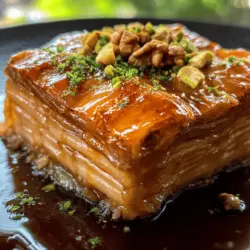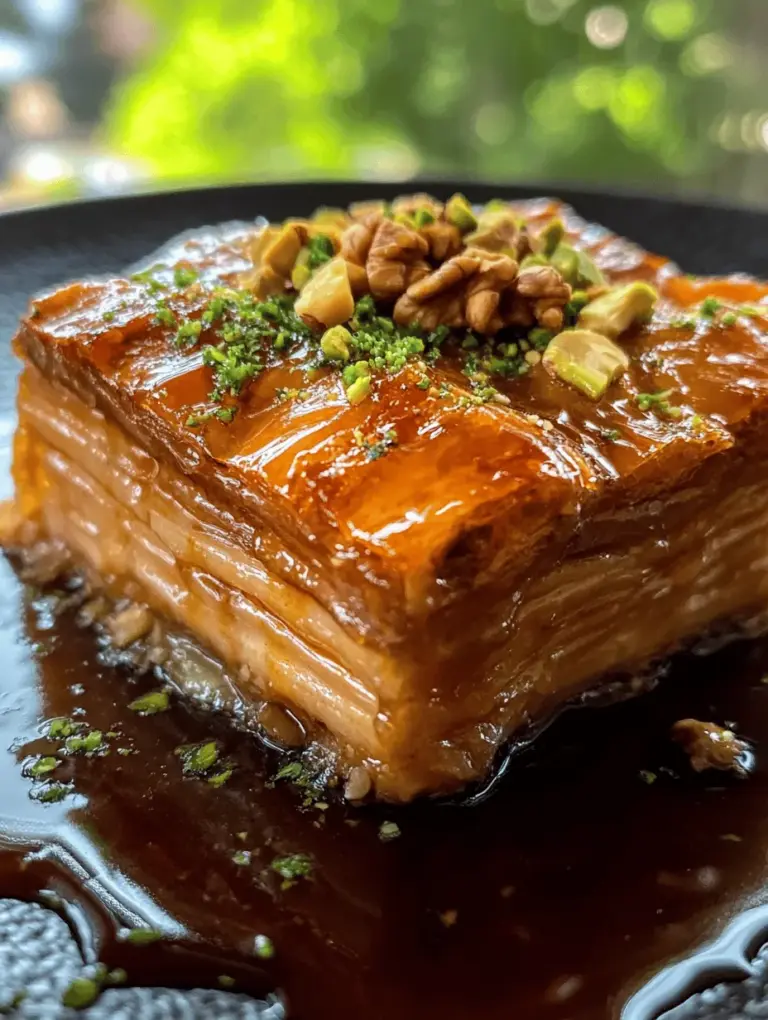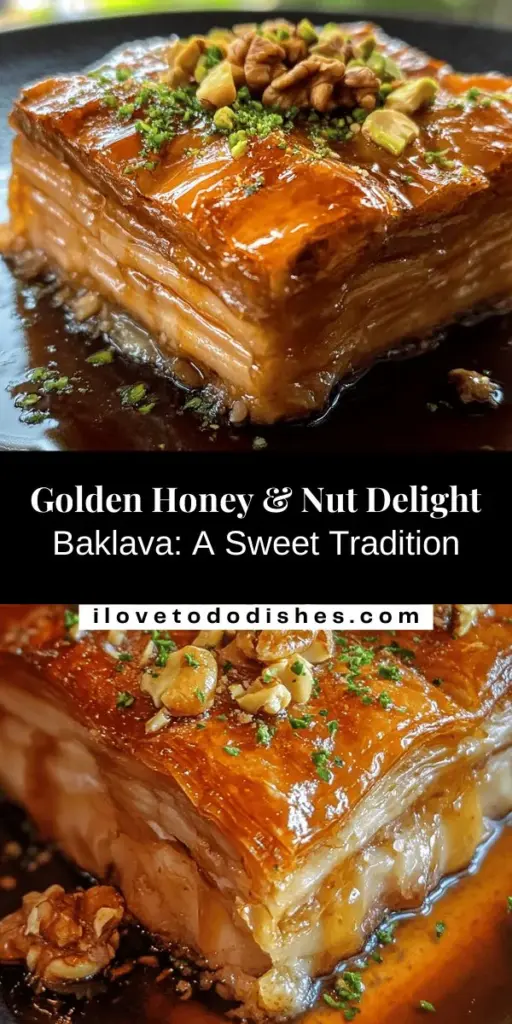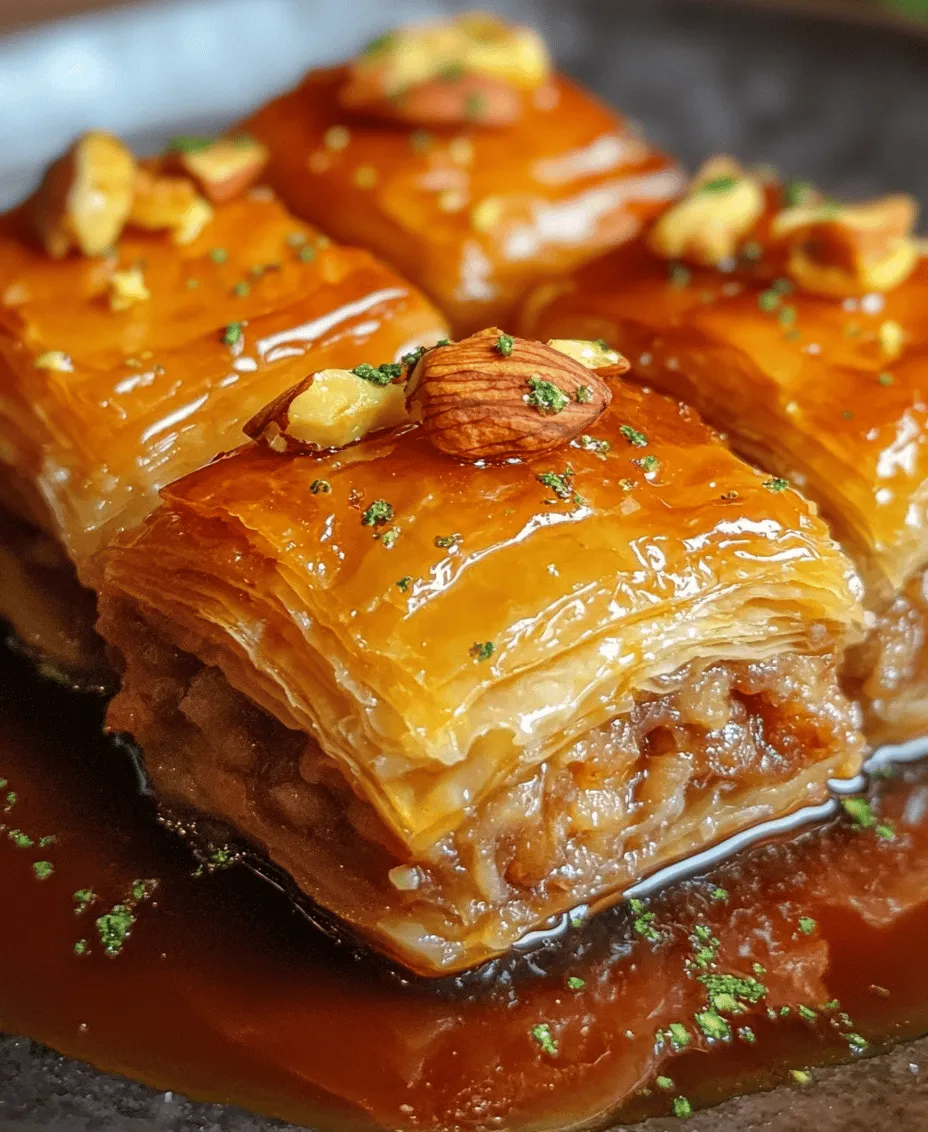Introduction
Baklava, a cherished dessert that has transcended borders and cultures, is more than just a sweet treat; it is a symbol of hospitality and celebration in many communities. Originating from the rich culinary traditions of the Middle East, this delectable pastry has found its way into the hearts (and stomachs) of people around the world. With its flaky texture, rich nut filling, and syrupy sweetness, baklava captures the essence of indulgence. Among the myriad of baklava recipes, the Golden Honey & Nut Delight Baklava stands out, offering a unique blend of flavors that pays homage to its traditional roots while introducing a modern twist.
This recipe is a delightful journey through the world of baklava, highlighting the importance of quality ingredients that enhance its flavor and texture. The Golden Honey & Nut Delight Baklava is characterized by layers of crisp phyllo dough, generously filled with a mixture of walnuts and pistachios, all drenched in a luscious honey syrup. The contrast of the crunchy nuts with the delicate layers of phyllo, combined with the sweetness of honey and the warmth of cinnamon, creates a truly unforgettable dessert experience.
Understanding Baklava
Baklava is a rich, sweet pastry made from layers of phyllo dough filled with chopped nuts and sweetened with syrup or honey. This indulgent treat has a long and fascinating history, believed to have originated in the ancient Ottoman Empire. Over the centuries, various regions have adopted and adapted baklava, resulting in a multitude of regional variations. From the nutty and syrup-soaked creations of Turkey to the honey-drizzled delights of Greece, each region boasts its own unique take on this classic dessert.
The key components of traditional baklava include phyllo dough and nuts. Phyllo, a paper-thin pastry, is the foundation of baklava, providing the signature layers that become beautifully crisp when baked. Handling phyllo can be a delicate process, as it tends to dry out quickly and can tear easily. However, with the right techniques, anyone can master this art. The choice of nuts varies by region; walnuts and pistachios are commonly used for their rich flavor and texture. The combination of these ingredients creates a delightful contrast, making baklava a true sensory experience.
Ingredients Breakdown
Phyllo Dough
Phyllo dough is the star of any baklava recipe, and its quality can significantly impact the final product. It is essential to use fresh, high-quality phyllo to achieve that perfect flaky texture. When handling phyllo dough, keep it covered with a damp cloth to prevent it from drying out. If you are using frozen phyllo, allow it to thaw in the refrigerator overnight, and be sure to work with it quickly to maintain its moisture.
Unsalted Butter
Unsalted butter plays a crucial role in baklava, enhancing both flavor and texture. It adds richness and helps achieve that golden-brown finish that baklava is known for. When preparing your baklava, melt the butter and brush it generously between the layers of phyllo to ensure each layer is infused with buttery goodness.
Walnuts and Pistachios
The nut filling is a defining characteristic of baklava, and in the Golden Honey & Nut Delight Baklava, we use a combination of walnuts and pistachios. Walnuts offer a robust flavor and a satisfying crunch, while pistachios add a touch of sweetness and vibrant color. Both nuts are rich in nutrients, including healthy fats, protein, and antioxidants, making them not only delicious but also a nutritious option.
Sugar and Honey
Sugar and honey are essential for sweetening the baklava and enhancing its flavor. While sugar is typically used in the syrup, honey adds a distinct floral note that elevates the overall taste. When combined, they create a syrup that beautifully soaks into the layers of baklava, ensuring each bite is decadently sweet.
Ground Cinnamon
Cinnamon is a spice that adds warmth and depth to the flavor profile of baklava. A sprinkle of ground cinnamon in the nut mixture infuses the baklava with a subtle hint of spice, balancing the sweetness and enriching the overall taste experience.
Vanilla Extract and Lemon Juice
Both vanilla extract and lemon juice serve to enhance the overall flavor of the baklava. Vanilla adds a fragrant sweetness, while lemon juice brightens the syrup, cutting through the richness and adding a refreshing touch. These ingredients work in harmony to round out the flavors and elevate the baklava to new heights.
Suggestions for Ingredient Substitutions
For those with dietary restrictions or preferences, there are several substitutions you can consider. For a gluten-free version, look for gluten-free phyllo dough options available at specialty stores. If you’re looking for a nut-free baklava, you can substitute the nuts with seeds like sunflower or pumpkin seeds. For a vegan alternative, swap the unsalted butter for coconut oil or vegan butter and use agave syrup in place of honey. These substitutions allow you to enjoy the delightful flavors of baklava while accommodating various dietary needs.
Preparation Steps
Prepping the Kitchen: Tools and Equipment Needed
Before diving into the baklava-making process, it’s essential to gather all necessary tools and equipment. You’ll need:
– A large baking dish (typically 9×13 inches or similar)
– A pastry brush for applying melted butter
– A sharp knife for cutting the baklava
– A mixing bowl for the nut filling
– A saucepan for preparing the syrup
– A clean kitchen towel to keep the phyllo dough covered
Having everything organized will make the preparation process smoother and more enjoyable.
Thawing and Handling Phyllo Dough
Thawing phyllo dough properly is crucial for achieving the best results. If using frozen phyllo, transfer it to the refrigerator the night before to allow for gradual thawing. When ready to use, unroll the phyllo sheets carefully, keeping the unused sheets covered with a damp kitchen towel to prevent them from drying out. This will help you avoid tears and ensure that the dough remains pliable while you work.
Preparing the Nut Mixture
For the nut filling, finely chop the walnuts and pistachios in a mixing bowl. The goal is to achieve a consistent texture that will complement the flaky layers of phyllo. You can use a food processor for a quick chop, but be cautious not to over-process them into a powder. Add in a sprinkle of ground cinnamon to the chopped nuts, mixing well to combine. This nut mixture is what will add a satisfying crunch and flavor to your baklava.
Layering the Baklava
Layering is perhaps the most critical step in creating beautiful baklava. Start by buttering the bottom of your baking dish with melted butter. Next, carefully place the first sheet of phyllo in the dish, brushing it with melted butter. Repeat this process, layering at least eight sheets of phyllo, buttering each layer generously. This will create a sturdy base that will hold the nut filling.
Once you have a solid base, sprinkle a portion of your nut mixture evenly over the phyllo layers. Follow this by adding three to four more buttered phyllo sheets on top of the nuts before adding another layer of filling. Repeat this process until all the nuts are used, finishing with a final layer of phyllo. Aim for a total of 20-25 layers to achieve that signature baklava texture.
Cutting the Baklava
After layering, it’s time to cut the baklava before baking. Using a sharp knife, cut the baklava into diamond or square shapes, making sure to cut through all the layers. This step is crucial as it allows the syrup to seep into the baklava once baked, ensuring that every piece is infused with flavor. Be gentle yet firm, and take care to create even pieces for a beautiful presentation.
With these initial steps completed, your Golden Honey & Nut Delight Baklava is well on its way to being a show-stopping dessert. Stay tuned for the next part of this recipe, where we will cover the final steps of baking, preparing the syrup, and serving this delicious treat.
Baking the Baklava
To achieve the perfect Golden Honey & Nut Delight Baklava, oven temperature and timing are crucial. Preheat your oven to 350°F (175°C), ensuring it reaches the desired temperature before placing your baklava inside. Proper heat distribution is vital for even cooking, allowing the layers of phyllo dough to crisp up beautifully while the nuts remain perfectly toasted.
While baking, monitor the baklava closely to avoid over-baking, which can lead to a dry texture. Keep an eye on the color—you’re aiming for a deep golden brown. The baking process typically takes between 45 to 60 minutes, depending on your oven’s calibration and the thickness of your layers. A well-baked baklava will have a crisp top and a slight crunch when tapped with a fork.
To determine if your baklava is done, look for an even, rich golden brown color across the top. If you notice that the edges are browning faster than the center, you can rotate the pan halfway through baking to ensure even cooking. Once you remove it from the oven, let it cool slightly before drizzling the syrup, allowing the layers to settle without losing their crispness.
Making the Syrup
While your baklava is baking, it’s the perfect time to prepare the syrup, which is a critical component of this dessert. To make the syrup, combine equal parts sugar and water in a saucepan, typically about 1 cup of each. Add in a splash of lemon juice and a few tablespoons of honey for added flavor. The acidity from the lemon not only balances the sweetness but also prevents the sugar from crystallizing.
Bring the mixture to a boil over medium heat, stirring until the sugar fully dissolves. Once it reaches a rolling boil, reduce the heat and let it simmer for about 10-15 minutes. The goal is to achieve a slightly viscous consistency; it should coat the back of a spoon without being too thick. Remember, once the syrup cools, it will thicken further, so aim for a pourable texture.
The scientific aspect of the syrup is fascinating. When hot syrup is poured over the freshly baked baklava, it seeps into the layers, creating a perfect harmony of flavors. The phyllo absorbs the syrup, which not only adds sweetness but also enhances the overall richness of the dish. This infusion transforms the baklava into a delightful treat that is crispy on the outside and tender on the inside.
Combining Baklava and Syrup
Once your baklava is out of the oven and your syrup is ready, it’s time to combine the two. The technique for pouring the syrup is important to ensure even distribution across the entire dish. Begin by gently pouring the cooled syrup over the hot baklava, starting from the edges and working towards the center. Use a ladle or a measuring cup for better control, ensuring that every layer gets a generous amount of syrup.
As the syrup seeps into the baklava, you’ll notice that the top layer remains crisp while the layers beneath become delightfully moist and flavorful. Allow the baklava to rest for at least several hours, or ideally overnight, before serving. This resting period lets the syrup fully absorb, enhancing the flavor profile and texture.
Serving Suggestions
When it comes to serving your Golden Honey & Nut Delight Baklava, presentation is key. Slice the baklava into diamond or square shapes for a classic look, and consider garnishing with crushed pistachios or walnuts for an extra touch of elegance. Serving it on a decorative platter can elevate the visual appeal, making it a stunning centerpiece for any gathering.
Pair your baklava with beverages that complement its rich flavors. Traditional options include strong Turkish coffee or aromatic herbal teas, both of which beautifully balance the sweetness of the baklava. If you’re feeling adventurous, try pairing it with a glass of sweet dessert wine, which can accentuate the honey and nut flavors.
Baklava also holds cultural significance, often served during special occasions and celebrations. It is customary in many Middle Eastern and Mediterranean cultures to share baklava with family and friends, symbolizing hospitality and joy. When serving baklava, consider sharing the story behind it, creating a deeper connection to the dish.
Storing and Reheating Baklava
To maintain the freshness and texture of your leftover baklava, proper storage is essential. Place it in an airtight container at room temperature, ensuring it is well-covered to prevent it from drying out. Baklava can be stored this way for up to a week, but it’s best enjoyed fresh.
If you need to store baklava for an extended period, consider freezing it. Wrap individual pieces tightly in plastic wrap and then place them in a freezer-safe container or bag. When you’re ready to enjoy your baklava, simply thaw it at room temperature. Avoid reheating it in the microwave, as this can make the layers soggy. Instead, warm it in a preheated oven at 300°F (150°C) for about 10-15 minutes to restore its crispness.
Nutritional Information
As delicious as baklava is, it’s important to be aware of its nutritional profile. A typical serving of baklava can range from 150 to 300 calories, depending on the size and specific ingredients used. The primary components—phyllo dough, nuts, honey, and butter—contribute to its rich flavor and texture but also to its calorie density.
Due to its sweet and rich nature, moderation is key. Consider enjoying baklava as an occasional treat rather than a daily indulgence. Pairing it with fresh fruit can help balance the sweetness and provide additional nutrients.
Conclusion
Creating and enjoying your own Golden Honey & Nut Delight Baklava is not just about the final product; it’s about the joy of the process and the celebration of flavors. The combination of crispy phyllo, rich nuts, and sweet honey syrup results in a dessert that is both indulgent and satisfying. The cultural significance of baklava as a shared treat enhances its appeal, making it a perfect option for gatherings or special occasions.
We encourage you to try making baklava at home, experimenting with different nuts or adding unique spices to create your signature version. Whether you stick to traditional recipes or explore variations, the experience of crafting this delightful dessert will surely be rewarding. Enjoy the process, share it with loved ones, and savor every delicious bite.



